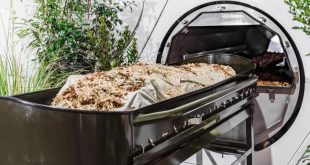
If you’d like a steady supply of homegrown food fast, whatever you do, grow radishes! Now is a great time to plant them because in summer they tend to bolt. You can use radishes to define rows between slower growing vegetables like beetroot and broccoli to remind you where you planted them, and, because they’re the fastest growing vegetable, you can already harvest them four weeks after sowing and they won’t interfere with these crops. You can even start harvesting earlier than four weeks to thin out the radishes so that the ones left have more room to grow!

What a lot of people don’t realise is that every part of the radish is edible and there are a myriad ways of cooking and eating them. In the last few weeks I’ve frequently had them as an early evening snack with cheese and biscuits, but I’ve been most surprised by how delicious they are baked, alongside pumpkin, and how fabulous the leaves are for making pesto. I used ground almonds instead of pine nuts for my version. You can also stir fry them, slice and marinate them in vinegar, honey and soy sauce, or simply saute them in butter and serve with fresh herbs salt and pepper as a side dish. You can grate them for coleslaw or chop and add them to potato salads. The greens can also be used in quiche or soup and the actual radishes are also wonderful in pickles.
Most importantly, once you’ve started to grow radishes, make sure you have at least one in a spot that you can leave for an extended period to let it go to seed. In January 2018 I harvested the seed from one radish in my home garden and we’ve been planting and harvesting radishes grown from that seed at Blackheath Community Farm ever since.

Our wonderful farm volunteers
The radish will take up quite a bit of space as it goes to seed, but you’ll discover how wonderful it is for attracting beneficial insects to the garden with all its flowers. Then you’ll have the joy of also eating radish pods. They’re crunchy and milder than radishes and can be eaten raw, cooked and pickled.

Once you see a central stem coming up the radish is going to seed and the root will be too woody to eat


Radish flowers and edible seed pods

The seeds are ready to harvest when the pods have dried out on the still growing plant

Check out the size of this root!
Apart from growing them to eat, radishes are fabulous as a cover crop for improving your soil. They cope well with our acidic soils in Blackheath. You can cast the seed over compacted areas in the garden, cover with a thin layer of organic matter and keep moist for 7-10 days to help them germinate. They’ll break up the soil and prepare it for your next crop. Chop off the greens for mulch (or to eat!) and let the radishes decompose in the soil to feed it and open up root and water channels.

There are many many varieties of radish. Sow small numbers of different varieties frequently and you won’t end up with a glut!




